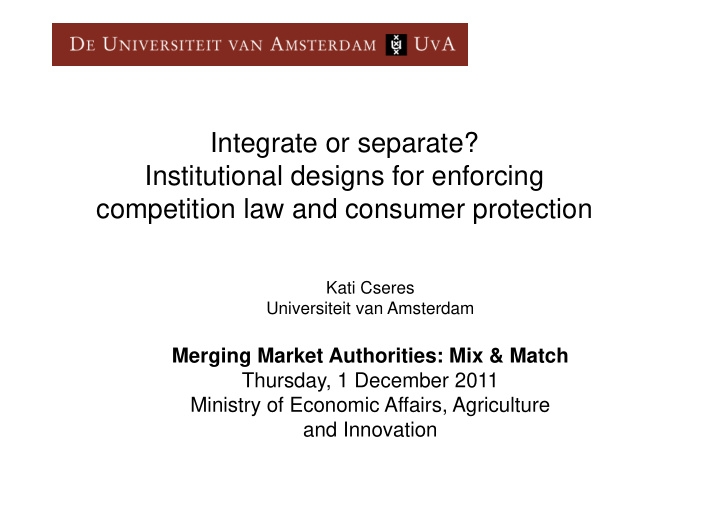



Integrate or separate? Institutional designs for enforcing competition law and consumer protection Kati Cseres Universiteit van Amsterdam Merging Market Authorities: Mix & Match Thursday, 1 December 2011 Ministry of Economic Affairs, Agriculture and Innovation
Legislative history Dutch Consumer Authority Regulation 2006/2004 intervening with traditional private public divide in Member States’ enforcement models of consumer law Explanatory Note to Consumer Enforcement Act 2005: “Most of the existing supervisory authorities control sector specific legislation such as the AFM and OPTA and for that reason they are unfit to provide general supervison as required by Regulation 2006/2004.” “While the NMa is a general supervisory authority, it, however, pursues a different perspective. It is mainly targeted at maintaining well-functioning markets which makes workable competition possible and which guarantees an optimal price-quality relation of goods and services and an efficient allocation of resources.”
Optimal agency design New challenges in liberalized and emerging markets Traditional divide consumer protection and competition law becomes hazy Market failures of complex nature unfair trade practices, unfair contract terms, switching, entry barriers, abuse of dominance Allocation of regulatory powers for competition law and consumer protection within one or separate agencies Wide diversity of institutional arrangements Country specific factors: legal administrative traditions, stage of economic development, political realities
Separate v. generic agencies Mandate of regulatory agencies Three models Integrated agency: CY, DK, FR, IE, PL, UK, NL Partially integrated agency: HU, IT, LT, LV, ES Competition law + Unfair trade practices Separate agencies: AT, BE, BG, CZ, EE, FI, DE, GR, LU, MT, PT, RO, SE, SI, SK,
Member State National Competition Authority National Consumer Authority Austria BWB Federal Ministry for Labour, Social and Consumer Protection Belgium Autorité Belge de concurrence Privacy Protection Commission DG Mediation and Monitoring Bulgaria Commission on protection of competition Consumer Policy Unit Cyprus CPC Competition and Consumer Protection Service Czech Republic UOHS Ministry of Industry and Trade Denmark Konkurrencestyrelsen Danish Competition and Consumer Authority Estonia Konkurentsiamet Consumer Protection Board Finland FCA Consumer Agency/Ombudsman Directorate-General for Competition, Consumer Affairs and Fraud L ´ Autorité de la concurrence France Repression Germany Bundeskartellamt Federal Office of Consumer Protection and Food Safety Greece The Hellenic Competition Commission General Secretariat of Consumer Affairs Hungary Gazdasági Versenyhivatal (GVH) Hungarian Authority for Consumer Protection Ireland TCA National Consumer Agency Directorate-General for Market Harmonization and Consumer Protection Italy AGCM (DGAMTC) Latvia KP Consumer Rights Protection Centre Lithuania CC State Consumer Rights Protection Authority Luxembourg CCM Ministry of Economic and Business Affairs Malta MCA Consumer and Competition Division Netherlands NMa Dutch Consumer Authority Poland UOKiK Office of Competition and Consumer Protection Portugal Competition Authority Consumer Directorate-General Romania Competition Council The National Authority for Consumer Protection Spain National Competition Commission National Institute for Consumers Sweden Swedish Competition Authority The Swedish Consumer Agency/Consumer Ombudsman Slovenia Competition Protection Office Market Inspectorate of RS Slovakia Antimonopoly Office The Ministry of Economy and Construction of the Slovak Republic United Kingdom Office of Fair Trading Office of Fair Trading
Pros of integration Single portfolio of policy instruments Economies of scope in access to resources and in efficacy of monitoring and accountability processes Share expertise: Integrated management and professional development Better coordination of enforcement at three stages: Identification of market failures case selection and allocation Assessment of competitive/consumer harm Remedies Avoid regulatory failures: agency captured by consumer agenda without proper appreciation of costs of regulation OR captured by regulated firms Wider visibility to community Public awareness, accountability, acceptance, consumer welfare
Cons of integration Differences in substance and implementation Competition law: general, horizontal and prohibitory in nature adaptable to industries and situations administrative proceedings and litigation, blunt instrument, small number of cases often large in absolute terms, formalized process Consumer law: industry specific, steering and prohibiting soft regulatory tools, many small cases varied in form, substance and instruments Australian Productivity Commission: consolidate consumer law Agency’s agenda might be dominated by competition law Limits on integration in practice: cannot be complete Strongly decentralized, scattered consumer protection
Checklist for policymaking Study and understand the different constituencies, different objectives Choice of enforcement tools Types of intervention: ex ante and ex post control Choice of remedies and sanctions Identify cross-junctions in the enforcement framework Align policy objectives and implement single tools Integration of policymaking and enforcement can take place through separate agencies and separation can exist within an integrated agency
Recommend
More recommend